 |
|||||||||
Music Webmaster
Len Mullenger:
Len@musicweb-international.com
|
Classical Editor: Rob
Barnett
Music Webmaster |
||||||||||||||||||||||||||||||||||||||||||||
| HANS PFITZNER
(1869-1949) The Orchestral Works and Concertos
available at a special reduced price |
|
|
|
|
|
|
INTRODUCTION
These five discs represent a treasurable co-production between CPO and Bavarian Radio. CPO's achievements seem to attract scant comment. This is surprising and disappointing when so much is made of the majors who have often shown less enterprise than this 'small' German label.
Their catalogue seems to have been created with the express purpose of filling gaps in the world's discographies. The repertoire ranges over a wide vista. They may be compared with Lyrita who have done so much for British music. However Lyrita's catalogue is smaller and new releases from them seem to happen once every decade (if we are lucky) on an irregular drip-feed. CPO keep issuing each month. Their catalogue is stable and easily available. I am not sure if CPO ever issued LPs (I doubt it) but they seem to have been a child of the CD era in which they have blossomed and flourished. Surprising projects pour out from them in cornucopia abundance.
Pfitzner is certainly an old-fashioned composer (as if that mattered!). His music is not far removed from Brahms and Schumann (he famously recorded the Second Symphony) although a twentieth century sensibility is certainly at work. Occasionally one can sense world events (and especially German ones) at work in this music although often those written contemporaneously with great tragic moments rarely (if ever) reflect tragedy. On the contrary they often suggest a retreat from the world or at least a failure to see its relevance to the world's tragedies.
CD1
Kleine Symphonie in G major (1939)
Symphony in C major (1940)
Das Fest auf Solhaug - three preludes (1890)
Bamberg SO/Werner Andreas Albert.
rec Bavarian Radio, July 1989, Nov 1989, Feb 1990.
CPO 999 080-2 [57.00]

The 1939 Little Symphony is in four movements: I Serenade-like with a touch of Smetana about it; II a pert trumpet-goaded allegro; III a near Mahlerian wallow of an adagio; IV a childlike village dance.
The Symphony for Large Orchestra (1940) opens with a commanding rolling horn-spurred theme and proceeds through multiple helpings of Schumann and Bruckner. If you can screen out the pompous moments (like 4.07) and concentrate instead on the refreshing emulation of Mendelssohn (Italian and Scotch symphonies), pass the outdoor sports festival atmosphere and get as far as the imperious (Rhenish) horn calls of the finale you will have heard a work of intermittently flaring flames.
The Ibsen-inspired Solhaug music is in three movements the first's undemanding ebb and flow rises to some crashing climaxes and is followed by the gentle dances of the peasantry in the second movement. The final section runs the gamut from moody scene setting, to Dukas-like liveliness to a clod-hopping dance.
CD2
Symphony in C sharp minor (1932)
Elegie und Reigen (1939)
Fantasie (1947)
Bamberg SO/Werner Andreas Albert.
rec Bavarian Radio, Feb 1990, May 1991, Nov 1991, March 1992.
CPO 999 136-2 [66.31]

This is easily the most impressive work in the collection indeed the whole of this disc has a lot going for it. Clearly the early-mid 1930s were a vintage time for Pfitzner (the best - and shortest - of his cello concertos dates from that time). The symphony, which is an arrangement of the String Quartet No. 3, launches off with a halting little tune. Moments of Mahlerian splendour cross the scenery but are offset by some strangely Debussian moments. Searing strings and an imperatively assertive tragic desperation which in the first movement reaches back more than twenty years to Elgar's Second Symphony and further in time to the Tchaikovsky of the late symphonies especially the Pathétique. The second movement with its virtual quotes of Beethoven 5 and 7 glistens with quirky fantasy. The following langsam is glorious - Korngoldian without the multi-strata complexities. A Prokofiev-style trumpet is also heard in this movement. The Finale is darting, tense, almost American, in its heaven-spanning energy, cutting and crashing through the textures. The work ends in satisfying tranquillity.
The Elegie prompts thoughts of Gerald Finzi's style especially the long musing clarinet solo. This then transforms into a slatey Elgarian darkness. Reigen is by contrast light jolly and a playground for swirling woodwind. The Fantasie is a very late work in three movements of which the first has elements of Mozartean style, Rachmaninov's gloom (Isle of the Dead) and a great ponderous waltz which is the antithesis of the dance. The very short second movement features Walter Forchert's solo violin - a soloist who shone in the Koch recording of Reger's Symphonic Rhapsody. The final movement's jerky fanfare reminded me a little of the brass dominated march from Prokofiev's Love Of Three Oranges. It ends without conviction or much sense of resolution.
CD3
Piano Concerto in E flat major (1922)
Volker Banfield (piano)
Munich PO/Werner Andreas Albert.
rec Bavarian Radio, Nov 1982.
CPO999 045-2 [37.50]
ANALOGUE (all the others are digital)

Pfitzner's voice often drifts into areas we may easily take as allusions to the most unexpected people. The opening of the piano concerto is pretty rugged and its fulsome romance is close to that of Rachmaninov - the last person I would have expected. The wings of the concerto are as the notes candidly point out somewhat clipped in this recording. The Marco Polo in which the soloist is Wolf Harden is similarly shorn of its full length. There is still room for a full length recording. Some critics have suggested Schumann as a reference point but for me (if we need references - and they are always useful in unfamiliar music) - the voices of both Brahms (Second Piano Concerto) and Mendelssohn come together in this Pfitzner work. Despite being the oldest of the recordings here the sound is very respectable.
CD4
Violin Concerto in B minor (1924)
Duo for violin, cello and orchestra (1937)
Scherzo in C minor. (1888)
Saschko Gawriloff (violin)
Julius Berger (vc);
Bamberg SO/Werner Andreas Albert.
Rec Nov 1989, Feb 1990
CPO999 079-2: [63 minutes]

The Violin Concerto seems to be extremely well played (I have not been able to trace comparative performances - Gawriloff is however a seriously dedicated violinist) has quite a few orchestral coups de theatres with a miniature central movement (of three) for orchestra alone, a rather charming Mendelssohnian accent and some striking effects in choosing orchestral 'spice' against which the soloist is to play. The Duo has charm a plenty and is well worth hearing without being utterly memorable. As with all these discs the recording quality is never less than respectable.
CD5
Cello Concerto in A minor (1888)
Cello Concerto in G major (1935)
Cello Concerto in A minor (1943)
David Geringas (vc)
Bamberg SO/Werner Andreas Albert.
Rec Nov 1992
CPO 999 135-2 [60.00]

Three compact cello concertos in one hour.
The 1888 work (25 mins) is, as expected, strongly Brahmsian, sporting a dewy brightness, flute highlights and a super-Mendelssohnian rush of strings at 8:50. It is not however as impressive a work as the notes imply.
The 1935 Concerto was written for Cassado and plays for just short of quarter of an hour. It is a work of high-water wonder and extraordinary richness and delight. There is a Chopin-like quality to the music and the accompaniment in the orchestra often has a fluttering Delian quality. At 6.13 there is a tolling song for the trumpets. Hollywood's 'hearts and flowers' sentimentality occasionally invades this work but does nothing to dampen its irresistible quality. Highly recommended.
The 1945 work is characteristic of the times: melancholy and typifying the work of Brahms and Bruch. The work sports cello and clarinet duos, a lively choppiness, peaceful repose and finally an insensitively hearty finale with one passage of congruous velveteen huskiness from the solo instrument.
CONCLUSIONS
This set parallels, in significance, the weighty LP set of the Pfitzner chamber music released by a German company (I forget which - Da Camera Magna?; anyone care to remind me) in the late 1970s. A set of some significance (only 3 of the 5 discs were ever reviewed in Gramophone!) and not at all short of enjoyment quotient.
If the music is occasionally ponderous you can set against this Pfitzner's evident dedication to beauty and drama.
If you cannot stretch to the reduced price for all five discs then certainly seek out the cello concertos, violin concerto and the 1932 symphony. There is much to enjoy in this set. All of this music is worth exploring although as indicated above the music does contain a few misfires.
Reviewer
Rob Barnett

HANS PFITZNER (1869-1949) THE COMPLETE STRING QUARTETS ON 2 CPO CDs Franz Schubert Quartett
Pfitzner contributed significantly to the field of chamber music. His works in this medium are:-
Cello Sonata in f sharp minor (1890)
Piano Trio (1896)
Piano Quintet (1908)
Violin Sonata (1918)
Sextet (1945)Only in the field of the string quartet was there more than one example of each grouping. He wrote four quartets and all are featured on athispair of well documented (French, English, German) CPO discs.
String Quartet No. 2 Op 13 in D major (1902)
String Quartet No. 4 Op 50 in C minor (1942)
Franz Schubert Quartett
rec 2-5 Feb 1993
co-production with Bayerischer Rundfunk
CPO 999 072-2 [54.01]

Pfitzner's complete orchestral music is resplendently done on five CPO discs. The company have now turned to his chamber music and with pleasantly implacable resolve seem intent on recording the complete output. The first stage is the string quartets. These two each last just under half an hour.
Pfitzner is sometimes mentioned in the same breath as Reger. In fact there is about as much in common between those two as between another pair often bracketed together (Bruckner and Mahler) in the dark ages of the 1950s and 1960s. Pfitzner is not a man to write wild and woolly mammoths of works and Max's penchant (to which he sometimes capitulates with joyous indulgence) for prolixity is not something you can associate with Pfitzner.
The two quartets stare at each other across a void of forty years: one written 12 years before the Great War and the other written in old age during World War II. Both are attractive works and the style has hardly changed over the years. The Bachian purity and Dvorák-like romance of the first movement of Op. 13 puts not a foot wrong. There is a delightful second movement with a refrain recalling Three Blind Mice, a third movement of bruising emotionalism and a finale in the spirit of some cheery German drinking song - brimming steins and all! The Op. 54 work is hooded and reserved in the first movement and in the langsam (III) assumes the Mozartian mantle of wit and dignified beauty. The finale (Allegro) is alive with a fantasy familiar from Elgar's Introduction and Allegro.
CPO's sensitivity to artistic needs is usually high. This is noted in a hundred and one little features: for example the good long gap between the end of the 1902 work and the start of the 1942 work. Documentation excellent.
Reviewer
Rob Barnett

String Quartet No. 1 in D minor (1886)
String Quartet No. 3 Op 36 in C sharp minor (1925)
Franz Schubert Quartett
rec 1-3 Feb 1993
co-production with Bayerischer Rundfunk
CPO 999 526-2 [73.17]

The D minor quartet is the work of a teenager. The first movement's debt is to Mozart and to the muscular Brahms of the first piano concerto. This is followed by a grand dance - halting, hesitant but grand nonetheless, a Bachian andante and a chuggingly affable Allegro finale.
The Op. 36 work is, in contrast, a work of Pfitzner's ripe maturity. The work is close to 40 minutes long and its epic scope translated into an orchestration as a symphony. Under this mantle it is probably better known. It is a work of great strength. The initial Ziemlich ruhig pitches and cants around the aural scenery in unbridled abandon: like sparks and brands flying out of one of Bernard van Dieren's string quartets (now there is a project for CPO) or the accompaniment to Warlock's song cycle The Curlew. The Sehr schnell is fast, ghostly - a leering nightride. The langsam third movement is a rocking Zemlinskian dream. The finale is passionate, bursting the fetters of the quartet medium and seeming to be more in the nature of a violin concerto complete with gypsy fire and searing cinders.
I look forward to later instalments of Pfitzner's accessible chamber music. Certainly recommended for the explorer - as also is the other CPO disc.
Reviewer
Rob Barnett

Sergei RACHMANINOV Symphonic dances Op.45. The Bells Op.34. Olga Lutsiv Ternovskaya Leonid Bomstein Vyacheslav Pochapsky Russian State Symphony Orchestra Valery Polyansky
Chandos CHAN9759 Full Price [73.05]
Sergei RACHMANINOV Symphonic dances Op.45. Isle of the Dead, Op.29 Royal Concertgebouw Orchestra Vladimir Ashkenazy
Decca 4307332 mid-price [54.46]
A consideration of two versions of the Symphonic Dances
I discovered the Symphonic Dances quite by accident in 1980 when I ordered a double cassette from Decca (a Mahler symphony I think) and found the second cassette to be correctly labelled but actually containing an incorrect tape of the most wonderful unknown music. I soon decided it was Rachmaninov and found that the other side contained the Isle of the Dead so this had to be the then new Ashkenazy recording. I have treasured those performances ever since.
Rachmaninov refused to talk about death and yet his music discusses it all the time - even in the Symphonic Dances the Dies irae stalks abroad. This was Rachmaninov's final work and he referred to it as a 'final flicker'. It was 1940, France had fallen and the world outlook was bleak. Rachmaninov was recovering from a minor operation on a secluded estate on Long Island. Ormandy was able to visit him for a piano run-through of the new score - Fantastic Dances in three parts Noon, Twilight and Midnight. These titles were soon withdrawn and the work renamed Symphonic Dances (many regard it as his fourth symphony). Rachmaninov quipped that this title was chosen so that the public would not be confused into thinking he had created a Dance Suite for Jazz Band. However the movements are written as dances and Rachmaninov hoped Fokine would make a ballet out of them. Fokine had been impressed by an earlier run-through of sketches at the piano and made the suggestion to Rachmaninov that he should relax his self-imposed stranglehold of strict waltz rhythm. Dance rhythms, nevertheless, are central to this piece.
The orchestration was started in the October whilst Rachmaninov was actually on tour. Every spare minute had to be utilized as it had to be completed in the December for an early January première. At the final rehearsal Rachmaninov said to the orchestra "Years ago I composed for the great Chaliapin. Now he is dead and so I compose for a new kind of artist, the Philadelphia Orchestra" Ormandy gave the first performance in Philadelphia and then it moved to New York. As with the First Symphony, the critical reaction was harsh - one description was of a mere novelty and a rehash of old tricks. Rachmaninov wanted to record the work but difficulties were deliberately put in his way to prevent this. The first recording was eventually made by the Chicago Orchestra under Dr Frederick Stock - which Rachmaninov greatly resented. Symphonic Dances did not meet critical approval until performed by Mitropoulos and the New York Philharmonic in 1942 after which Rachmaninov was given a surprise 50th birthday party and received a present of a new piano from Steinway.
By now Rachmaninov was feeling ill and tired and had to abandon his 1943 tour. He was hospitalised and diagnosed with melanoma cancer. He died on March 28th 1943.
Being dances, these pieces are intensely rhythmical. The first dance opens with a soft ticking on the strings which you could tap out as follows:
| 1 2| rest |1 2| ./. |rest |3 4| |5 6| |7 8| ./. |1 2| |3 4| |5 6| |7 8| ./. etc.
The cor anglais overlies this with a three-note motif with the third long-held; a motif that is heard throughout the movement. The strings increase from pp to ff and the dance is stamped out in an irregular rhythm involving two then three then four notes in the bar - molto marcato (strong accentuation). There is an immediate difference here between Ashkenazy and Polyansky and their conducting styles happen to be mirrored by the recordings. Ashkenazy produces an exciting, driven performance which sounds as if it is twice as fast as Polyansky although it is actually only 10% faster. This is matched by a typical bright close-up sound by Decca which loses much of the Concertgebouw hall resonance. It is an exciting recording that has impressed me for years and everything seems crystal clear -- but is it? I have always favoured the Ashkenazy over all other recordings but Polyansky is the only conductor to make me listen to this work afresh. His recording from the Moscow Conservatoire has a warm natural acoustic and indeed yes I can hear more. His pace is steadier, which is surely how it would have been if danced, and this allows each player time to phrase their parts and make more impact. At 6 after [4] there is a piano entry that reinforces the basses and contrabassoon and underpins the trumpets. This is barely noticeable in the Concertgebouw recording but it comes out very clearly with Polyansky. After all this intense rhythmic activity the movement dissolves into a pastoral passage for oboes and clarinets and a marvellously slinky alto saxophone. Whilst far from inaudible in the Ashkenazy recording Polyansky's sax produces a more virtuoso performance - almost like listening to Jan Gabarek. It is points like this that enable one to hear a work as if with new ears.
I can sum up my first movement impressions by saying that Polyansky is more flexible in his approach to rhythm, supported in this by a virtuoso orchestra, and he allows his instrumentalists time to phrase and present a passage that may go for little or nothing with Ashkenazy. I have been very impressed, so can this now become my first recommendation? This flexibility is most obvious in the waltz of the second movement where Polyansky constantly varies the tempo introducing hesitations and slight accelerandi to produce the swaying ebbing and flowing of a real dance; Ashkenazy is more set on speed. Philip Taylor in the accompanying notes refers to this passage as valse triste - parts are reminiscent of the Sibelius - it is more valse and much more triste with Polyansky. Ashkenazy gains a whole two minutes on Polyansky in this movement, which is an incredible difference and yet, even so, I have never felt that Ashkenazy lacked anything when it came to expressiveness. I regret that Polyansky's much slower speed does becomes self-indulgent and he begins to lose its way. When my mind starts to wander something must be wrong. This is the critical movement to hear if you are wondering whether to purchase this performance. I can admire the way in which it is done without always approving of it.
Polyansky recovers in the third movement; midnight sounds and the orchestral sound flickers and then there is a wonderful energetic melody on the strings which Philip Taylor identifies as a Russian Orthodox chant. The quiet reflective section that follows again emphasises the different approach of the two conductors. With Ashkenazy it passes without incident; with Polyansky it is much slower, almost grinding to a halt but what a wonderful bass clarinet leading us to the allegro vivace. Polyansky brings out the supernatural in this work. It is in the climax itself that Polyansky's approach reaps dividends. With Ashkenazy the climax is almost perfunctory but Polyansky makes a majestic climax topped off through the taking of a little liberty with the tam-tam which is well and truly wound up with each stroke, culminating in a long held crash that only slowly dies away. Laisser vibrer indeed!
The Polyansky is faultless as a recording and make the Ashkenazy now sound a little brash but overall it is still the Ashkenazy performance I would want for repeated listening. On wide-range equipment here is a noticeable hum on the Decca recording at the very opening. Either it dissappears after that or I just get used to it. It has never marred my enjoyment of the disc. [I have been listening to the original full price recording and this may have been improved on remastering.] But there are further considerations. The Ashkenazy is now at mid-price and is coupled with a truly magnificent, compelling Isle of the Dead; unbeatable at any price. This make the Decca the must-have disc. Polyansky has the earlier cantata The Bells. My gripe with Chandos here is that they have presented the text in English, German and French and Russian cyrillic. This makes it quite impossible to follow and must have involved considerable expense in typesetting. The usual practice is to include a transliteration that can be followed alongside the english text.
Reviewer
Len Mullenger
Ashkenazy

Polyansky

Rogeri Trio, John McCabe (piano), Mark Messenger, (violin) Helen Roberts (viola), Martin Outram (viola), Julian Rolton (piano)
Naxos 8.554352

Save around 22% with
Crotchet
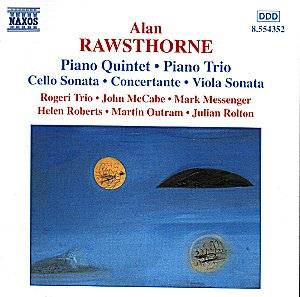
With the release of this CD, the whole of Rawsthorne's published chamber and instrumental music becomes available, on a variety of CD labels. Three of the five works in the compilation appear on CD for the first time and one, the Viola Sonata, is a world première recording. The works span the whole of Rawsthorne's composing life. The performances are built around the Rogeri Trio, who are joined by colleagues, as the various ensembles require.
Quintet for Piano and Strings (1968) - Nadia Myerscough and Mark Messenger (violins), Helen Roberts (viola), Peter Adams ('cello) and John McCabe (piano).
This provides a striking opening to the disc. The first bars presage the drama which characterises most of the music on the CD and the impeccable ensemble in what is to follow. Rawsthorne had a keen dramatic sense, which is heightened by the narrative quality of his writing - these characteristics were established early in life, as his juvenile writings, plays, prose and poetry, disclose.
The Quintet is the latest of the pieces on the disc yet, by making full and robust use at the resources available, it does not share the austerity of some other works of this period, rather it looks back to the Quintet for piano and winds of 1964. The drama derives from the use of contrasts of dynamics and tempi and the imaginative opportunities which the basic, terse, motivic and harmonic materials afford. This is an authoritative performance, first because John McCabe participated in the première, before which he had the benefit of the composer's direction on matters of interpretative detail, secondly on account of the committed playing. Throughout the composer's indications in the score are faithfully realised, ensuring balance and clarity of argument, structure and texture.
This is not easy music, but with the benefit of repeated hearings, which this CD now affords, the integrity of the writing will be revealed to the assiduous listener. One cannot imagine better advocates for the work and its composer.
Concertante for Violin and piano (1937) - Nadia Myerscough (violin) and Yoshiko Endo (piano).
This was Rawsthorne's first published composition, one which drew substantially on two early attempts to write a violin sonata. The piece is in ternary form, bravura outer sections enclosing a slow and ruminative episode. The work discloses that the composer's distinctive language was already well on the way to being established.
This is an impressive recital piece which receives a splendid performance. The exacting demands placed on both piano and violin are fully met. The duo demonstrate their understanding of the idiom and make their convincing best of the opportunities the composer provides. Though a comparatively early piece the composer thought it worthy of a place in his oeuvre since he permitted its re-publication in 1968 after making minor revisions.
Trio for piano, violin and 'cello (1962) - The Rogeri Trio (Yashiko Endo [piano], Nadia Myerscough [violin]. Peter Adams ['cello]).
The three movements, Introduction, Capriccio and Theme and Variations, play without a break. Rawsthorne wrote a note which discloses that "much of the material is based on a phrase of six notes, with its inversion. This is used to fashion both melody and harmony, in various manipulations, and is often only hinted at merely by implication". Whilst this may appear somewhat academic, austere and self-limiting, it is belied in performance. The composer employs familiar, well-tried and contrasting devices, which he reworks imaginatively, the instrumental colour combinations being inspired rather than constricted by the limitations of the trio combination.The theme of the Theme and Variations is an example of this, where the presentation of the diatonic theme is made with textural lucidity and simplicity conjured from the most basic use of the instruments.
Prior to the recording the Rogeris had this piece well established in their repertoire, including a BBC broadcast, and it is good to have the accumulated benefits of that experience preserved here in an exemplary performance.
Viola Sonata (1937) - Martin Outram (viola) and Julian Rolton (piano).
Sonatas for viola are few, the most notable twentieth contributor to the genre being Hindemith with his four sonatas. Hearing the opening bars of this Sonata might lead one to believe that this is a fifth of the same provenance, such is the pungent harmony and assured declamation in the first bars. This is soon dispelled by the early emergence of Rawsthorne s unmistakable fingerprints. The first movement Allegro, which follows the introduction is, apart from an slower interlude, an earnest toccata. The intense mood is followed through into the following scherzo, almost in thee character of a perpetuum mobile, (an early use of his favoured tarantella-like treatment) embedded within which are contrasting interludes. The Adagio third movement is tenebrous, containing at its heart a lamentatory motif which was to be recalled when Rawsthorne composed his deeply-felt Elegiac Rhapsody in 1964 marking the death of his friend, the poet Louis MacNeice. The final Rondo reminds one again of Hindemith, though the flexible tonality of the theme is very true to Rawsthorne and characteristic of much that was to follow in this vein in subsequent year. Here the mood contrasts with what has gone before, an amiable emergence into the light after so much dark inwardness and intensity.
The performers, like the Rogeris, had this work in their repertoire well before the recording, being advocates for the piece at such gatherings as the Viola Congresses and Festivals. The work has difficulties for both performers, not least intonation for the violist and, together, of ensemble. These do not intrude upon this assured performance, one which should encourage performers and promoters to programme it.
The idiomatic writing for both instruments derives from Rawsthorne's study of both piano and 'cello. This Sonata embraces a wide range of emotions within its fifteen minute span, the most predominant being lyrical. The three movements, which make up its overall structure, are far from self-contained. Each section of the work shares common materials, which are so distinctive as to permit the ear to discern without difficulty the path and ingenuity of their development. Any performance needs a wholehearted approach and utilization of the many expressive opportunities afforded to both players. These qualities are to be found here in abundance, notably the vocal quality of the 'cello writing which, especially in the tenor register, is well realised. The soloists clearly listen to each other and maintain a decorous balance, except in one or two of the fortissimo declamatory passages where the 'cello is momentarily overlaid; a matter of recording balance as much as anything, but this does not detract from a very satisfying performance.
The acoustic of St. Martin's Church, East Woodhay, is on the dry side, yet perhaps appropriate for the larger ensemble pieces, where the detail of the polyphonic writing needs to be clearly audible. This disc is a highly valuable and accessible addition to the growing Rawsthorne discography at bargain price.
Reviewer
John Belcher

John Belcher is chairman of the Rawsthorne Trust
OTTORINO RESPIGHI (1879-1936) Sinfonia Drammatica (1914) Slovak PO/Daniel Nazareth
rec Feb 1986, Bratislava NAXOS 8.550951 [ 58.23]
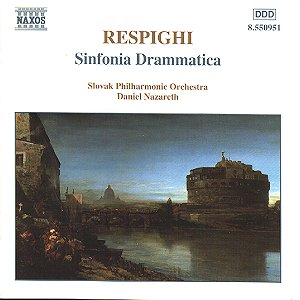
There are three movements in this work - a symphony from Respighi. This is no neo-classical jolly, no pastoral reflection but a great gangling colossus of a work written in a mood racked with conflict and striving.
The work can loosely be grouped with Szymanowski's Concert Overture, Enesco's Symphony No. 1 and Scriabin's Symphonies 2 and 3. It is contemporaneous with the following symphonies: Langgaard 2; Miaskovsky 3 (whose ruined castle grandeur it partly shares); Rangstrom 1 (similar strenuous lyricism); Tournemire 5 and the desperate high-straining songs of Vermeulen 1 (with which again it has parallels).
The Respighi is launched with an Allegro energico (23.12) letting rip with rapturous Straussian climaxes crackling across the first five minutes. Though hardly glamorous the very natural sound-picture is well caught in the oboe song at 5.58. There are large helpings of Mahlerian declamation by the horns (try 7.54 onwards) and music that flows into moments from Pohjola's Daughter. Scriabin-like protestation, as in 10.42, and the hoarse calling of the brass section in full cry are also a hallmark of this work. This gradually winds down into a central Siegfried Idyll-like middle interlude. Long black Tchaikovskian (Pathetique) shadows are cast across the scenery at 18.03. At the conclusion a Delian march is translated into an extremely impressive Mahlerian fanfaring processional of satisfying gravitas and splendid sunset triumph.
The central andante sostenuto is the shortest movement at 17.06. It is largely of distanced plainchant emotion in a Debussian idiom. This rises to a sombre climax in which the brass call out in agony. A much more contained and calm mood settles like silvery dust over the rest of the movement though disturbing undercurrents keep rending the gentle blaze of Mahlerian light.
The finale is an Allegro Impetuoso (18.04) which, in this performance, might actually have benefited from a more buffeting dash but only by a hair or so's breadth. Howard Hanson was a Respighi pupil and Respighi's influence can be traced back through these pages as also may the influence of Respighi on Korngold or vice versa. Other parallel voices are clear: Wagner, Bruckner, Strauss and even Elgar 2 (10.55). The grand swing of the bells in doom-laden ruins echoes angrily through the closing moments of this symphony - a prelude (unwitting or otherwise) to the murderous conflict about to grip Europe for the next four years.
The strings, which are perhaps not as numerous as they might be, are romantically warm (III 3.20) but not as lush as those of the BBCPO. The brass and woodwind are excellent. The recording is good without being absolutely brilliant. It benefits from being played back at a high volume. The notes are just about adequate though very brief. More information about the symphony would have been welcome.
The later (1994) recording by the BBCPO/Edward Downes is on Chandos CHAN9213 runs for one hour and is in more sumptuous sound. That issue is of course at full price but this too, at least half the Chandos price, has its mead of voluptuous euphony.
A glorious rest from the usual helping of Roman tone poems. Not the most subtle of symphonies but one with its share of high pressure poetry. No-one who invests in this disc in curiosity is likely to be disappointed by the performance. The music has the very variegated emotional surge you might have expected from the title.
Reviewer
Rob Barnett

NIKOLAI RIMSKY-KORSAKOV (1844-1908) Scheherazade [44.00] Russian Easter Festival Overture [15.00] Joakim Svenheden (violin) London PO/Jose Serebrier
rec 9-10 March 1999, Watford Colosseum REFERENCE RECORDINGS RR-89CD [59:26]
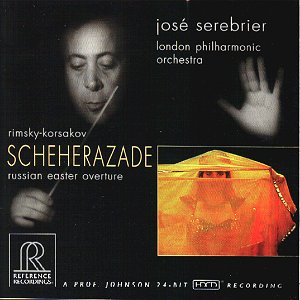
This is an unsurprising coupling of two of the most popular works in the orchestral literature. Their impact as display pieces is often stressed as if this quality militates against or cancels out their musical value. In fact the two qualities are perfectly complementary.
What is so attractive about these two works is the excellence and memorability of the musical ideas and the sense of fantasy which imbues every bar. Would that Serebrier would now turn to the similarly ecstatic and exotic (though even finer) Antar another 'Symphonic Suite' although finally dubbed 'Symphony No. 2'.
Jose Serebrier knows the LPO well having conducted them in his own meticulously prepared recoridng of Charles Ives's Symphony No. 4 back in the 1970s for RCA (now BMG). His own extensive notes recount his mission to cleanse the orchestral parts of Scheherazade from decades of conductors' accretions and elisions. He also gives his own overview of conductors' styles taking in names such as Reiner, Monteux, Ormandy, Ansermet, Bernstein, Beecham and a conductor with whom Serebrier worked as assistant in old age, Stokowski.
As a showcase Scheherazade is well served by RR's technical know-how and accomplishment although frankly the listener very soon loses all preoccupation with such matters as the music speaks freely and with lively command. The Colosseum seems a reverberant acoustic and must have taken some mastering. As it is bloom and space are not lacking yet detail is nicely preserved and communicated to the listener. The big moments are spectacularly caught as in the quick crescendo at the end of The Young Prince and the Princess. The helter-skelter piccolo solo at 6.53 in the Bronze Warrior finale is staggering; but then much of the playing here is possessed. The mixture of early Christian mysticism and pagan debauch that stalk the Russian Easter Festival Overture are conveyed with similar fervour. For all of Serebrier's concern for authenticity the performances have no trace of pedantry. Instead they flow with life and dramatic poetry.
Film music fans who may not otherwise know the work would do well to hear this disc for Scheherazade in particular is a work much quarried for inspiration when deadlines press and bank accounts gasp.
All in all a refreshing and surprising event for those who thought they knew their Rimsky.
Reviewer
Rob Barnett

Royal Philharmonic Orchestra Dirk Joeres
BIS CD-1055 63m DDD.
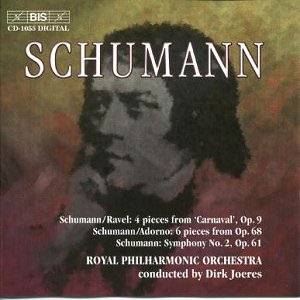
You may be thinking, Why is BIS issuing yet another Schumann Symphony cycle, surely we are well served by Gardiner's outstanding new DG set? The answer lies in the couplings; newly discovered orchestral arrangements of the composer's piano pieces, interesting and intriguing makeweights in their own right and deserving of re-incarnation. Joeres is a fiery conductor and his tempi for the Carnaval pieces show that the music is not that suited to an orchestral guise. Still, much fun is to be found in the Paganini piece whilst the Davidsbundler march comes across perennially well. The same goes for the exquisite 'Kinderjahr', a true study in harmony and invention The Mendelssohn movement is particularly charming whilst 'Kmecht Ruprecht' is also very beautiful. With the symphony I turned to my trusty old Sawallisch version, which won me over in my days of youth! Although Joeres and the RPO are evidently much attuned to this Cinderella-like score, there is none of the unique vision that is constantly flowing through the Dresden version. However, Joeres holds the structural flow well enough and his dreamy Adagio espressivo is very beautiful where it is so easy to lose interest. A fiery Finale tips the balance slightly but again, Sawallisch is quite difficult to beat. The BIS recording is outstandingly clear and focused whilst the programme notes are keen and highly informative. It will obviously depend on the couplings if you already own one of the many Schumann symphony sets around.
Reviewer
Gerald Fenech
Performance:
Sound:

. Hanne Fischer, Marianne Rorholm, Roland Wagenfuhrer, Dietrich Henschel, Bo Anker Hansen. Danish National Radio Choir, Danish National Radio Symphony Orchestra. Michael Schonwandt.
Chandos CHAN 9760 74m DDD.
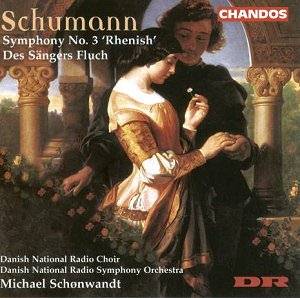
Another new Schumann cycle, you may be saying and after BIS' recent release of the Second we are surely being spoilt for choice. The interesting thing and trump card to both new issues are their couplings; on the Swedish label, orchestrations of piano music, with Chandos it appears to be the choral works which have been given prominence. I have already enthused and waxed lyrical about Michael Schonwandt and his conducting of the DNRSO, a prestigious ensemble that really warrants first-class attention. His Schumann is measured and beautifully controlled, almost burnished in its lyrical intensity. The First Movement gains particular exuberance from this reading with bold firm thematic shaping and particular prominence given to the brass which is absolutely superb, especially in the coda. The same geniality informs the Scherzo and the wonderful third movement, a study in relaxed concentration. I always enjoy comparing the 'Feirlich' movement with Wolfgang Sawallisch's mercurial account with the Statskapelle Dresden in 1973. I can safely say that Schonwandt and the DRSO match that exclusive recording perfectly, but the Chandos recording is much better. In the Finale, Schonwandt crowns a wonderful interpretation with panache and aplomb, making this recording the most desirable of all Thirds at the moment.
The cantata 'Des Sangers Fluch' is vintage Schumann. With its wonderful pensive choral settings and mercurial solo contributions, it is quite comparable to the 'Faust' and 'Pilgerfahrt' settings, something which I will hope for from these Danish forces. One can also relish with bated breath and await further discoveries such as this almost unknown 'The Minstrel's Curse'. Hane Fischer makes a delightful Queen whilst Rorholm's narrations are colourful and alert in their responsive enunciations. The male soloists are less satisfactory although Bo Anker Hansen is quite alert in his contribution as the King. The real star in this work is the orchestra and the DRSO are absolute stars in portraying the colourful nuances of the subtle orchestration. Schonwandt's conducting is forthright and firm, rather in the mould of Gardiner but he has the benefit of a superbly responsive band. As usual, Chandos' presentation is superb with a beautiful box and libretto accompanying the jewel case. I shall be eagerly awaiting further instalments in this cycle and will begin by placing this issue at the top of my Schumann shortlist for the present.
Reviewer
Gerald Fenech
Performance:
Sound:

JOSE SEREBRIER (b. 1938) Partita (symphony No. 2), Fantasia (string orchestra), Sonata for solo violin, Winterreise (orchestra) * Gonzalo Acosta London PO/composer
REFERENCE RECORDINGS RR-90CD [60:14]
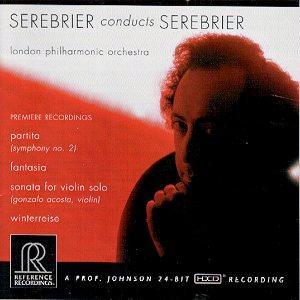
Partita (symphony No. 2) (1958) [28.26]
Fantasia (string orchestra) (1960) [12.08]
Sonata for solo violin (1948) [7.30]*
Winterreise (orchestra) (1999) [6.59]
Reference Recordings have a long-standing relationship with José Serebrier as conductor. That relationship has brought us some extremely fine discs. Apart from their obvious technical accomplishment RR's choice of repertoire with Serebrier is more than creditable. I have already reviewed their Rimsky (RR89), Janacek (RR 65 and 75) and Chadwick (RR64 and 74). The Chadwick and Rimsky discs are outstanding.
The RR team now offer a selection of Serebrier's own works and they do so in their accustomed splendid sound. The symphony No. 2 is more of a suite than a symphonic statement. It comprises four varied orchestral movements with little in the way of organic linkage. The incidents are often attractive and extremely colourful (well caught here) and can be rewardingly appreciated as a suite hence the primary title of 'partita'. The first movement's pot-pourri of Latin-American figures and rhythms prompts thoughts of one of Serebrier's benefactors and influences: Aaron Copland (El Salon Mexico). The finale is bright and ends in percussive salvoes.
The Fantasia is an extremely fine work of romantic demeanour. Its song-orientated approach prompts thoughts of Arthur Bliss in his most athletic vein of lyricism (Music for Strings). This is certainly a work you will want to hear again. The more forbidding format of a sonata for solo violin is always a challenge. Violinists may listen to such recordings in technical appraisal but what of the general listener? In fact this work is of a riper vintage than you might have feared. Overtly virtuosic, its cartwheels and high-voltage gymnastics have a compulsion of their own. Certainly it is not a desiccated work and in my judgement more instantly attractive than say the Frankel or Bartók solo sonatas.
The Winterreise violin concerto was written as a partner for a 20th century collection of concertos each taking the seasons as its subject: Milhaud Spring Concertino, Rodrigo Concierto di Estio (a deeply attractive work - too easily eclipsed by Aranjuez) and Chaminade's Autumn. The project was unable to locate an extant 'Winter' concerto so Serebrier was approached. Serebrier based Winterreise on this concerto which has some rather frenetic slavonic desperation alongside recollections of Glazunov's Winter movement from his ballet The Seasons. This is a pretty clamorous score and when it isn't loud it is gloomy as in the Dies Irae at 5.40 and or licked by Walküre flames as at 6.24.
Two works stand out in this company: Winterreise and the Fantasia. Both feature compelling invention and I would like to hear more by this Uruguayan composer/conductor. The recording quality and documentation is typically of high quality although I regretted the absence of recording date and venue details (perhaps I missed them?).
Reviewer
Rob Barnett

As for the future at Reference Recordings:-
They have just recorded a program of orchestral music by the American composer Dominick Argento with Eiji Oue and the Minnesota Orchestra -- all world premieres -- including "Valentino Dances," which feature an accordion.
At the same sessions, they took down a miscellany of short works including "Les Preludes" by Liszt, Ravel's "Bolero" and rarities by Klemperer, Jarnefelt, Deems Taylor and others. Both will be out in the first quarter of 2000.
A FESTIVAL OF NINE LESSONS & CAROLS From Kings College, Cambridge Choir of Kings College, Cambridge directed by Stephen Cleobury
EMI 2CD set CZS5 73693 2
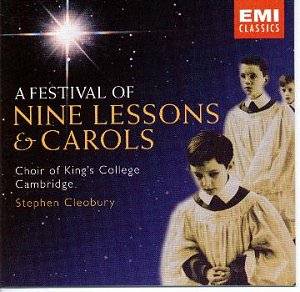
The Carols
Once in Royal David's City (descant Cleobury)
Up! Good Christian folk, and listen
The Truth from Above (arr. Vaughan Williams)
Adam lay ybounden (Boris Ord)
Sussex Carol (arr. Ledger)
In the bleak mid-winter (Harold Darke)
In dulci jubilo (arr. R.L. Pearsall)
God rest you merry, gentlemen (arr. Willcocks)
A Tender Shoot (Otto Goldschmidt)
The Lamb (John Taverner)
Gabriel's Message (arr. Pettman)
Joy's Seven (arr. Cleobury)
Dormi, Jesu (John Rutter)
Riu, riu, chiu (?Mateo Flecha the elder)
The Fayrfax Carol (Thomas Adès)
While shepherd's watched (descant Cleobury)
I saw three ships (arr. Willcocks)
Illuminare, Jerusalem (Judith Weir)
O come, all ye faithful (descant Cleobury)
Hark! The herald angels sing (Mendelssohn, descant Cleobury)
Perhaps, for many, like myself, Christmas really begins at 3:00 pm on Christmas Eve when the annual Festival of Nine Lessons and Carols is broadcast by BBC Radio direct from Kings College Chapel in Cambridge. Many (myself included in my younger days when I lived close-by in Peterborough) will have queued since the early morning (some hardy souls even through the night) to be part of the audience for this unique Christian celebration.
This recording of the Service includes not only the carols I have listed above but the nine lessons (traditionally read by representatives of the Choir, the Church, and the colleges of Cambridge) prefaced by a Bidding Prayer and rounded off with an organ voluntary - In dulce jubilo (J.S. Bach).
There are many favourite carols included. It is good, for instance, to see Boris Ord represented by his lovely 'Adam lay ybounden' based on a 15th century source. Many of us will remember not only one of the first recordings of excerpts from the Festival, made by Ord, and released on the old Argo label, but also Boris in the first televised carol programme from Kings back in 1954 (there is a photograph of him reading the lesson in the booklet). Another popular Kings figure, David Willcocks, is remembered, too, and he is represented by two of his carol arrangements: 'God rest you merry, gentlemen' and 'I saw three ships.' That other fine Kings' organist, Philip Ledger, is represented by his beautiful arrangement of the Sussex Carol. One must not forget Harold Darke either. His gorgeous 'In the bleak mid-winter' (based on a text of Christina Rossetti) has long since been a special favourite of mine.
It has become a tradition to include new carols each year. Judith Weir and Thomas Adès were both former students of King's College. Both have works in this programme. The Adès 'Fayrfax Carol' has bell-like tollings and skirts along the edges of tonality/atonality. I was very attracted to the purity of John Taverner's 'The Lamb' and to John Rutter's lovely 'Dormi, Jesu.'
The booklet notes are by Stephen Cleobury who gives a fascinating history of the Festival and all the texts of the carols and the readings are included.
Clearly, no recording could replace the immediacy of the real event but this recording might be regarded as an introduction in the days preceding Christmas or as an alternative if for some reason one has to miss hearing it on the radio or seeing it later on TV. Hearing that wonderful descant on the middle verse of 'O come, all ye faithful' we know, indeed , that Christmas has arrived.
Reviewer
Ian Lace

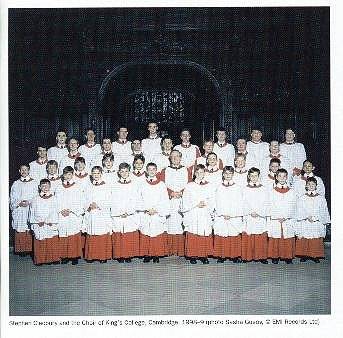
The Choir of Wells Cathedral Rupert Gough: Organ, Malcolm Archer.
Hyperion CDP 12101 68m DDD.
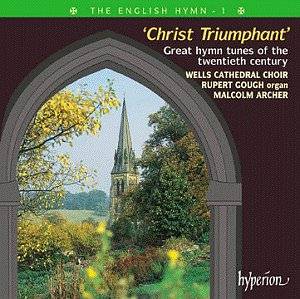
After seven marvelous volumes of 'The English Anthem', Hyperion continue to dig provincial English choral music out of the back alleys with this mouth-watering collection of anthems. The volume is marked as the first in a series so we can look forward to a host of releases jam-packed with goodies like this one. Those of you familiar with the BBC series, 'Songs of Praise' will know what I'm raving about. Well-known items such as 'Christ Triumphant ever reigning' and 'I Vow to the Thee my Country' (almost commercial since Lady Diana's funeral) rub shoulders with some exquisite rarities such as 'For all the saints' and 'Lead Kindly Light'. We also discover some outstanding beauty in 'Praise the Lord of Heaven' and Salisbury's enchanting 'Holy Spirit ever Dwelling', an outstanding exercise in choral beauty. All twenty-two numbers have something special to them and I recommend the listener to sample each piece over and over again, you will be hooked by the sublime pattern that is so characteristic to the English Hymn. The Choir of Wells Cathedral are a self-recommending bunch of singers and the direction of Malcolm Archer is quite exemplary. The cover design is also immediately striking whilst the notes are very detailed and make interesting reading. Those who have collected the English Anthem need not hesitate whilst newcomers should investigate with vigour; this is surely not to be missed.
Reviewer
Gerald Fenech
Performance:

Sound:

Hallé/VPO/NYPSO/Orchestras Sir John 'Tita' Barbirolli.
Dutton Laboratories CDJSB1999 155m ADD.

Save around 22% with
Crotchet
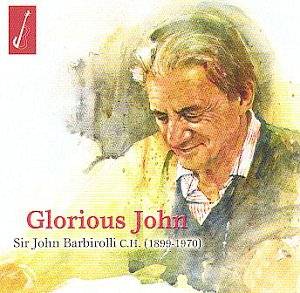
ONE HUNDRED YEARS OF GLORIOUS JOHN
This album is really 'Glorious John' from his very first beginnings as a cellist in 1911 right to the 'beloved memory' of 'Sheep may safely graze' in 1969. It is a testament to one of Britain's finest conductors ever, a true champion of the podium, figures like him are sadly no longer with us but those fortunate enough to have knew him will rejoice in this embarasse de riches, as I a recent convert of this spellbinding artist rejoiced. Van Biene's 'Broken Melody' starts us off this voyage and here one admires the bowing of Sir John accompanied by his trustworthy sister Rosa. It is apt that the first operatic excerpts should be Italian, indeed Zanelli's 'Niun mi tema' is shattering for its unrestrained emotion, one could almost imagine 'Tita' groaning along with him! Particularly interesting are the Balfe 'Bohemian Girl' Overture and Weinberger's 'Christmas' recorded with a Symphony Orchestra and the NYPSO which were never to feature in later recordings. The same could be said of the delightful 'Sir Toby' Overture by Anthony Collins, remarkable for its drive and verve. The first disc ends with a wonderful 'Euryanthe' and a mesmerizing 'Walk' by Delius both featuring the war ravaged VPO in performances that have to be heard to be believed.
The second disc is exclusive Hallé territory. Stravinsky's 'Concerto in D' comes to life in a remarkably precise performance whilst the delightful Mozart 'Cassation' and Minuet from Divertimento No. 11 makes us feel a bit perplexed why Barbirolli did not record more Mozart. Probably to make way for his beloved Grieg whose Lyric Pieces sound so exquisitely heart-warming that one almost cringes with pleasure when listening to this particular 'Secret'. The Villa Lobos Bachianas Brasilieras No 4 is full of fantasy and imagination particulary in the expansive 'Corale' With the wonderful 'Gold and Silver' waltz and the ethereally slow 'Sheep may safely graze' we are almost at an end of Sir John's long career. The Bach is particularly beautiful the music almost groaning along, so reminiscent of Sir John's way with the composer's he loved, that is squeezing every last drop of emotion out of the notes. The disc is supplemented by a delightful rehearsal sequence with Sir John singing along to Berlioz and a splendidly charismatic interview with Ronald Kinloch Anderson espousing on the various stages of the conductor's chequered career. This album is a wonderful treasure, indeed it is a tribute to 'Glorious John of beloved memory'.
Reviewer
Gerald Fenech
Performance:

Sound:
/

Hallé Orchestra/BBC Symphony Orchestra Sir John Barbirolli
BBC Legends BBCL 4013-2 78m Stereo/Mono.
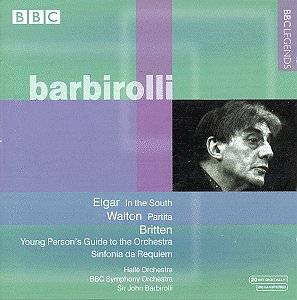
I had recently been charmed by Sidney Beer's rare account of 'In the South' available on Dutton but this magnificent interpretation by Sir John surely carries all before it in dramatic sweep and heart-on-sleeve beauty. It is a work that seemingly eluded Barbirolli until his very last year but the maturity of the interpretation is such that one could not imagine improvement. From the opening exuberance of the Hallé through to those marvelously poetic interjections by solo violin and horn, Sir John's in inimitable grasp of the score is only equaled by Elgar himself, obviously the latter is in much inferior sound. The conclusion is also wonderful with a sure steady grasp and a powerful declamation ending the work in a flourish typical of 'Glorious John'. The recording is also very clear and thus we have a version of 'In the South' for posterity, pity it has been so long in coming. Another work, which is definitely associated with Sir John, is Walton's 'Partita for Orchestra', something which he conducted often as Michael Kennedy tells us. All four movements are dispatched with exemplary panache and a disarming feel for the score that is demonstrative of the interpretive powers of this great conductor. In Britten's 'Sinfonia da Requiem', Sir John is at pains to point out the structural power of this awesome piece especially in the grief stricken 'Requiem Aeternam', a sure prelude to the sinisterly great 'War Requiem'. With the famous 'Young Person's Guide to the Orchestra' Barbirolli is indeed on home ground. His subtle coaxings and rhythmic inflexions galvanize the orchestra into one whole virtuoso instrument. It is indeed an exemplary conclusion to a fabulous disc that preserves some of the greatest performances from the final years of Glorious John and shows him at the height of his powers just a few months before he died. Skeptical collectors should purchase this disc and the Barbirolli magic will work miracles! A fine memorial to this most charismatic conductor in his centenary year.
Reviewer
Gerald Fenech
Performance:

Sound:

Evelyn Rothwell: Oboe, Halle' Orchestra/New Philharmonia Orchestra Sir John Barbirolli, Valda Aveling, Wilfred Parry, Dennis Nesbitt.
Dutton Barbirolli Society Edition CDSJB 1016 78m ADD.
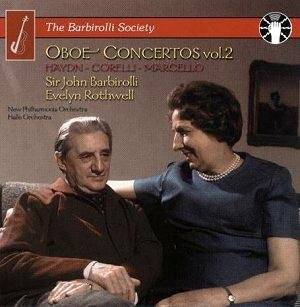
One of the finest partnerships in the history of recorded music, that between Sir John Barbirolli and his wife Evelyn Rothwell had been almost forgotten until a splendid issue on Dutton featuring a number of wonderful concertos arranged by these two sensitive artists. This second volume is as much a tribute to Sir John than to Evelyn Rothwell for it even includes a number of sonatas where Mrs Barbirolli is accompanied by such distinguished artists as Valda Aveling and Dennis Nesbit, pioneers of harpsichord and viola da gamba respectively.
The Haydn Concerto is conspicuously 'big-band' but the grand manner of Barbirolli's conducting beautifully matches Rothwell's mercurially lilting tone especially in the expansive Allegro spiritoso. The 1957 PYE recording is miraculously clear, in the Andante one is enchanted by phrasing, breathing and all sorts of clicks from the oboist, surely not intrusive but participative. The Marcello Concerto is from the last year of intensive recordings for the conductor. This pays dividends as the beautiful melodies are almost wrung out with expressive conducting of the highest order. I was particularly charmed by the serene Adagio, majestic music, sublime even, in these outstanding artists' hands.
With the Corelli, Barbirolli switched orchestras and the wholesome rounded sound of the New Philharmonia may sound a bit old fashioned but there is much to enjoy nonetheless. The real bonuses here are the solo Rothwell items, which show her status as one of the world's finest oboeists in those days. CPE Bach's Sonata in G is accompanied with great vigour by Valda Aveling and Dennis Nesbitt whilst the arrangements of Loillet's Sonata in C and Handel's 'Air and Rondo are wonderfully accompanied by Wilfred Parry. It is indeed good to have these performances back on disc.
Aveling and Nesbitt return for Telemann's Sonata in E and Head's Siciliana, both fine examples of Rothwell's supremely confident art. As usual with Dutton, Lyndon Jenkin's supremely eloquent notes adorn this splendid issue, almost the 'icing on the cake', at least to a young enthusiast like me. I'm sure that fans of this partnership will not even hesitate whilst newcomers to this magical music should take a dip and get hooked - for life!
Reviewer
Gerald Fenech
Performance:

Sound:

London Philharmonic Orchestra/*BBC Symphony Orchestra Sir Thomas Beecham.
Dutton Concert Classics CDEA5508 73m ADD (Rec: 1945).
Bargain price
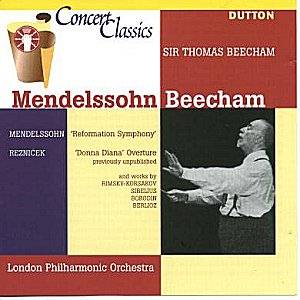
This delightful collection of Beecham's post war work with the LPO has been previously available on an impeccable Biddulph release recorded and transferred with exemplary clarity by Mark Obert-Thorn. Still Michael Dutton's transfers are better and reveal greater sense of bloom and presence in what were always difficult recordings to bring out. The real thriller is Beecham's magnificent 'Reformation' symphony, probably one of the best performances ever.
He finds a grandeur and élan in the score that eludes most conductors at the expense of blatant theatricality. My particular favourite is the dashing Finale taken at a walloping pace and increasing excitement. Strangely enough, Beecham never did it again in the 50's, so one can only dream what Jack Brymer would have made of the delightful opening of the 'Ein fest Burg' theme. The other items are vintage Beecham in the best sense.
There has rarely been a more colourful account of 'May Night' whilst the dashing excerpts from Berlioz's 'Les Troyens' find conductor and orchestra in perfect harmony and bliss especially with the swaggering 'Trojan March'. The addenda to that Biddulph disc are fascinating as much as they are intriguing. An incredible 'Donna Diana' should have been a Beecham hallmark, its availability is indeed cause for rejoicing and it has an infinite swagger that dwarfs Karajan's rather excellent VPO account from 1947. The Sibelius items are accorded much better sound and the interpretations are particularly exciting.
All in all with Lyndon Jenkins' authorative notes and some beautiful presentation, this Dutton disc goes to the top of the Beecham discography file, thanks again to Mike Dutton!
Reviewer
Gerald Fenech
Performance:
Sound:
/

Lowri Blake, cello & Hugh Webb, harp
LOWRI RECORDS - LOWRI 2001 [55:39]
Real audio samples and purchase from http://www.lowrirecords.com
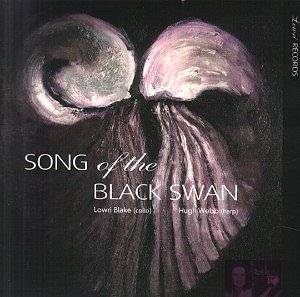
Villa-Lobos: Song of the Black Swan, Ravel: Piece en forme de Habanera, Martinu: Arabesque no. 6, de Falla: Canciones populares espanolas, Castelnuovo-Tedesco: Sea Murmurs, Elgar: Chanson de Matin & Salut d'Amour, Debussy: Beau Soir, Saint-Saëns: The Swan, Fauré: Berceuse op. 16 & Sicilienne op. 78, Ketèlby: The Phantom Melody, Gershwin: Prelude no. 2, Berkeley: Andantino, Bantock: Hamabdil, Tchaikovsky: Valse Sentimentale, Van Goens: Scherzo op.12
This album continues an on-going collaboration between cellist, Lowri Blake, and harpist, Hugh Webb. As Lowri Blake points out, there is comparatively little repertoire for this instrumental combination, such that this album necessarily relies heavily on arrangements of works written for other forces. There seems little point in discussing the validity of this; musicians and composers have been re-arranging each other's work for as long as there has been music, only in deciding if a particular set of arrangements is worthwhile. Here the answer must be a resounding yes, for Song of the Black Swan is a captivating anthology.
Packaged in a gatefold card sleeve, and thus resembling a miniature LP, the album immediately stands out. It is elegantly designed in an imperial purple, and features (as do all releases on Lowri records) a painting by Louise Blair. The sleeve is actually divided into three sections, with the CD residing in the central partition when not in use. I am not sure about the durability of this, as it requires rather more nimbleness than usual to remove and replace the disc without tearing or otherwise damaging the sleeve. The packaging is attractive, but I doubt it will survive all but most careful owners.
One further point, before praising the recording itself. The notes on the music are woefully lacking, offering comments only on two of the nineteen tracks, while also adding that only the title piece, by Villa-Lobos, and Hamabdil by Granville Bantock were originally written for cello and harp. There is considerably more information, not about the recording, but about Lowri Blake and the other artists on Lowri Records, on the website at www.lowrirecords.com, which may be just about acceptable if Lowri Records are only available through the website, but not if they are to be also sold through other outlets. Not everyone has access to the World Wide Web, and I really feel that some of this information should appear with the disc itself. Still, Lowri Records, launched in October this year, is a new venture, and there is time for things like this to improve.
For those who don't know, and to quote the website: "Lowri Blake has a dual career as a solo cellist and as a singer of contemporary music and cabaret. Since her televised concerto debut with the BBC National Orchestra of Wales, Lowri has broadcast over one hundred recitals and concertos on BBC Radio and Television… She has appeared with the London Philharmonic Orchestra in performances of the Elgar Concerto, conducted by Matthias Bamert, at the Royal Festival Hall in London…. Lowri is professor of cello at Trinity College of Music and at the Royal College of Music, London and gives masterclasses nationwide and abroad."
Hugh Webb meanwhile is the composer of The Snow Queen and active as a classical, contemporary and jazz harpist, active in film, television and popular music.
The recording offers 19 miniatures, some of which will inevitably be more familiar than others. My personal favourite must be Martinu's beguiling Arabesque no. 6, clearly a favourite with Ms Blake too, who rightly calls it a "little gem". Villa-Lobos The Song of the Black Swan has the elegant long lines of the bird, magnificently preening its feathers. Very notable in this new guise, are two familiar piano pieces by Fauré, Berceuse op. 16 and Sicilienne op. 78. Elgar's Chanson de Matin also has great appeal - you may be interested in Lowri Blake's transcription of Elgar's violin Sonata in E minor for cello, recorded on Lowri Records release Lowri 2000. The pieces which may be less melodically striking are still enchanting, transported by the sheer dream-like beauty of the almost magical sound-world created by the fine interplay of cello and harp - even when the cello seems to dominate, these are genuine duets, conversations between players and instruments. Through this dialogue, come performances both melodically sensitive and deeply atmospheric. Complimenting the musicianship, the acoustic is perfect, lending the music that wonderfully English warmth which so characterises releases on the Chandos label.
This is good music, not musical wallpaper, yet it is also an album to relax into, to drift (swanlike?) through. If it were not a dirty term, and a contradiction, this release might be labelled New Age classical, though don't let that put you off. From whatever angle this album is approached, it is a delightful collection.
Reviewer
Gary S. Dalkin

Educational CD-Rom India Musica (Interactive Guide to Hindustani Music)
Magic Software pvt ltd
(India Musica website www.magicsw.com/iMusica Email: mail@magicsw.com )
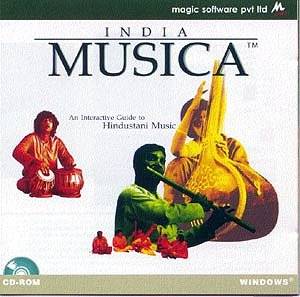
Educational CD-Rom
India Musica (Interactive Guide to Hindustani Music) Magic Software pvt ltd
This educational CD-Rom can be considered in conjunction with Nimbus's The Raga Guide (reviewed in S&H, September 1999, Immersion in Indian Music). It is a multi-media guide to styles, instruments, personality and the philosophy of Hindustani music.
There are introductory sections covering its religious aims and the role of the guru. The names of notes and scales are translated, with brief sound illustrations. Ragas are described and particular moods attributed to them and to individual notes. The importance of performing at the right time of day is stressed.
There is a vast compendium of illustrated biographies of popular performers, vocal and instrumental, present and past, which provides easy enjoyment and a good impression of the variety of styles, and this is perhaps the most valuable part of the enterprise. Some of these are sound only, others with video, both of variable quality. They will be invaluable to prospective purchasers bemused by the vast numbers of CDs of Indian music now available.
The indexing and cross referencing is impressive. There are numerous cross-links to pursue between the main categories Forms, Instruments, Personalities, Ragas & Talas. (There are 37 entries under the letter A alone!). Sometimes these links will lead to a specific article, in others to just a passing reference in another text.
It is full of assertions to be accepted as given, never convincingly described for the uninitiated. All aspects are named and defined. There is however sometimes a frustrating gap for Western listeners between the plethora of names and the lack of really meaningful illustrations. This limits the possibility to transfer theoretical information into better understanding and appreciation of what is happening in actual concert situations. Many of the brief sound illustrations do not give more than a snapshot impression, and are not capable of being extended into real understanding.
For interested European listeners it is easy to become overwhelmed by a multitude of technical terms. The real problem remains the oral teaching tradition in India, so that with all its classified information, and computer links around the contents, India Musica often leaves us without being able to make real sense of what one reads and hears.
This is an attractive CD-Rom to sample and explore, but the final acquisition of insight and knowledge available from it is limited. Perhaps the only solution, for the few sufficiently committed, is to undergo the traditional training under a guru?
Meanwhile, there is scope for another CD-Rom, which might combine the best of the ideas in this one with the detailed exposition of Ragas in Nimbus's The Raga Book, with its four CDs. I applauded the core of that enterprise, a four minute version of the raga Alhaiya bilavi, fully transcribed in its entirety, but wished that others of the miniature performances had been transcribed similarly.
What is especially lacking in both productions is a visual demonstration in real time of the rhythmic cycles of the talas. This is essential for beginners who hope to learn to keep track of what is happening and, in particular, to be able to appreciate those flights of fancy which singers, instrumentalists and percussionists indulge in before returning eventually to the beginning of a cycle, to the evident delight of knowledgeable listeners.
It would help immeasurably to have had, made visible, the hand-clapping routines, and also to see the melodic line passing before one on screen, as is achieved with notable success in one of the earliest classical CD-Roms (Beethoven Sonatas Op. 22, 26 & 53, Pollini - the score passes in front of your eyes as Pollini plays, a yellow cursor keeping your place, and you can even edit and print it out, adding your own fingerings!) [review Deutsche Grammophon 435 472-2].
However, as of now both India Musica and The Raga Book are educational aids which can be welcomed and recommended as worth while purchases.
(India Musica website www.magicsw.com/iMusica Email: mail@magicsw.com )Reviewer
Peter Grahame Woolf

Collection: The Only Opera Album You'll Ever NeedVarious Performers
RCA Victor/BMG 75605 513562 * CD1 [68:10] / CD2 [72: 46] mid-price
Save around 22% with
Crotchet
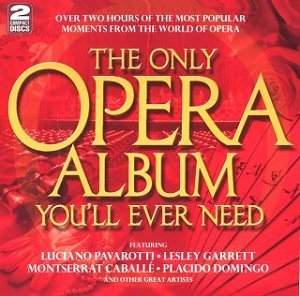
CD1:
A Midsummer Nights Dream: Verdi - Brindisi (La Traviata)
Fatal Attraction: Puccini - Un Bel Di (Madama Butterfly)
Dangerous Liaisons: Handel - Ombra Mai Fu (Serse)
Diva: Catalani - Ebben? Ne Andro Lontano (La Wally)
Moonstruck: Puccini - O Soave Fanciulla (La Boheme)
Driving Miss Daisy: Dvorak - Song to the Moon (Rusalka)
Prizzi's Honour: Donizetti - Una Furtiva Lagrima (L'Elisir d'amore)
Trainspotting: Bizet - Habanera (Carmen)
Mrs Doubtfire: Rossini - Largo Al Factotum (The Barber of Seville)
Sunday Bloody Sunday: Mozart - Soave Sia Il Vento (Cosi Fan Tutti)
The Witches of Eastwick: Puccini - Nessun Dorma (Turandot)
Bizet: Toreador Song (Carmen)
Gershwin: Summertime (Porgy and Bess)
Delibes: Flower Duet (Lakme)
Purcell: When I am Laid in Earth (Dido and Aeneas)
Verdi: Grand March (Aida)
CD2:
The Lone Ranger: Rossini - William Tell Overture (William Tell)
Moonraker: Leoncavallo - Vesti La Giubba (I Pagliacci)
Amadeus: Mozart - Der Holle Rache (The Magic Flute)
Gallipoli: Bizet - Au Fond du Temple Saint (The Pearl Fishers)
Apocalypse Now: Wagner - Ride of the Valkyries (Die Walkure)
Bizet: Seguedille (Carmen)
Puccini: E Lucevan Le Stelle (Tosca)
Offenbach: Barcarolle (The Tales of Hoffman)
Verdi: Chorus of the Hebrew Slaves (Nabucco)
Mozart: Voi Che Sapete (The Marriage of Figaro)
Bellini: Casta Diva (Norma)
Verdi: La Donna E Mobile (Rigoletto)
Gluck: Che Faro Senza Euridice? (Orfeo ed Euridice)
Mozart: Non Piu Andrai (The Marriage of Figaro)
Verdi: Celeste Aida (Aida)
Tchaikovsky: Entr'acte and Waltz (Eugene Onegin)
Of course it seems a very strange thing for a record company, in the business of selling records, to claim that any sort of album is the only one of its genre you will ever need. However, this determinedly populist anthology is clearly aimed at a market that does normally buy opera recordings, but which is familiar with releases along the lines of 'Now that's What I Call…', and which might be tempted to purchase an opera set which gathers all the 'famous bits' together for easy consumption. Indeed, the booklet notes have the flavour of a beginners guide: "These two CDs feature thirty-two extracts from the greatest operas of all time, sung by world-famous artists, to move, excite and thrill you. Welcome to the magical world of opera!" And with that welcome, far from being the only opera album you will ever need, RCA must hope that this lavish collection will serve as a super sampler and appetiser for further explorations of the catalogue.
From a film point of view, the set lists the movies in which many of the pieces have been featured (though not necessarily these particular recordings). There is at least one omission, for the very first track, 'Brindisi' from La Traviata, can be heard in the most recent film adaptation of A Midsummer Night's Dream, and the cover fails to record this fact. Perhaps the film is too recent. In total 15 of the 32 pieces are associated with films, several others with advertisements, and one with a football competition. Apart from The Lone Ranger, these films tend only to date back as far as the 1970's, and most are of more recent vintage than that. Whether this indicates that using opera in film is a relatively recent thing - given that the leitmotiv approach of much film scoring is derived directly from opera, one should think not - or whether it is simply that selections from opera have recently been given especial prominence, usually as a shorthand indication of aspirations to quality film-making.
Whatever the reasoning behind the selections, this is a good value collection, which, while inevitably alienating the opera purists (for whom in any case it is not intended) serves its purpose. The sound quality is obviously variable, especially so given that the selections span five decades, but is always adequate and is frequently excellent. Further, these are good performances by some of the most famous names in classical music. RCA have dusted down the back catalogue, and while the earliest recording dates from 1950, a surprising number are very recent, showcasing albums recorded in the last two or three years. Here we have Jussi Bjorling, Montserrat Caballe, Lynn Dawson, Placido Domingo, Leslie Garrett, Angela Gheorghiu, Della Jones, Vesselina Kasarova, Luciano Pavarotti, Leontyne Price, Robert Merrill, Janice Watson, and such equally famous conductors as Carl Davis, Sir Edward Downes, Herbert von Karajan conducting orchestras ranging from the London Symphony Orchestra to the Vienna Philharmonic and the Orchestra of the Royal Opera House, Covent Garden. Clearly an impressive collection of top names, though anyone considering buying this set because of Pavarotti's name on the cover should be aware that he appears only on one track: a duet from La Boheme, recorded live in mono with soprano Mirella Freni in 1967.
Even if the titles are unfamiliar, every piece should be instantly recognised. Here are many of the great set-pieces of opera, from the impassioned romanticism of 'Un Bel Di' from Madama Butterfly - which being the song of a woman rejected by her lover, actually had a thematic relevance to the film which appropriated it (Fatal Attraction) - to the exhilarating ferocity of Wagner's 'Ride of the Valkyries' (used unforgettably in Apocalypse Now), and the rambunctious 'Largo Al Factotum' from The Barber of Seville (heard in Mrs Doubtfire). Presented in this form, shorn of recitatives and less well known arias, makes the music as accessible as popular, and there is really no reason why almost anyone could not enjoy what is ultimately a collection of great music. Resolutely not a release for serious opera buffs, but for the general listener, someone who likes a bit of classical music but doesn't know where to begin with opera, or the film music enthusiast curious about some of the opera selections heard from time to time in the movies, this is as good a place to begin as any. It provides a painless, good value doorway into the world of opera, and for that can really only be commended.
Reviewer
Gary S. Dalkin

Collection: THE ONLY MUSICALS ALBUM YOU'LL EVER NEED!Various artists including: Michael Ball, Elaine Paige; Marti Webb; Philip Schofield; Julie Andrews and Marilyn Monroe
RCA VICTOR 2-CDs 74321-60825 2 Mid-price
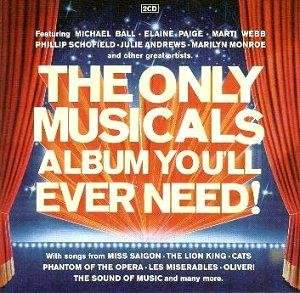
This cheeky and rather OTT title proclaims a collection of 38 fabulous numbers from musicals old and new. My reviewing job is easy - just look at what you get! Roll back the carpet and then turn the lights down low, snuggle up to someone special and enjoy -
Reviewer
Ian Lace

CD1
'Love Changes Everything' - Aspects of Love (LloydWebber/Black/Hart) - Michael Ball
'Losing My Mind' - Follies (Sondheim) - Cleo Laine
'Last Night of the World' - Miss Saigon (Schönberg/Maltby/Boubil) - Joanna Ampil & Peter Cousens
'If I Can't Love Her' - Beauty and the Beast (Menken/Rice) - Ethan Freeman
'With One Look' - Sunset Boulevard (Lloyd Webber/Black/Hampton) - Kim Criswell
'Unusual Way' - Nine (Yeston) - Elaine Paige and Jonathan Price
'The Music of the Night' - Phantom of the Opera (Lloyd Webber/Hart/Stilgoe) - Marti Webb and the Philharmonia Orchestra.
'Can You Feel the Love Tonight?' - The Lion King (John/Rice) - Sean McDermott.
'Memory' - Cats (Lloyd Webber/Nunn/T.S. Elliot) - Maria Friedman.
'Talk to the Animals' - Doctor Dolittle (Bricusse) - Philip Schofield and Julie Andrews
'Big Spender' - Sweet Charity (Coleman/Fields) - Jacqueline Dankworth; Josephine Blake; Shezwae Powell and girls.
'Money' - Cabaret (Kander/Ebb) - Alan Cumming and the Kit Kat Girls
'All that Jazz' - Chicago (Kander/Ebb) - Caroline O'Connor & Company
'America' - West Side Story (Bernstein/Sondheim)
- Charlotte d'Amboise; Debbie Gravitte and Ensemble.
'Bring Him Home' - Les Miserables (Schönberg/Boubil/Kretzner) - Colm Wilkinson
'Climb Every Mountain' - The Sound of Music (Rodgers/Hammerstein) - Lesley Garrett.
'The Impossible Dream' - Man of La Mancha (Leigh/Darion) - Colm Wilkinson
'Don't Cry for Me Argentina' - Evita (Lloyd Webber/Rice) - Stephanie Lawrence
'Send in the Clowns' - A Little Night Music (Sondheim) Cleo Laine.CD-2
'There's No Business Like Show Business' - Annie Get Your Gun (Berlin) - Ethel Merman.
'I Get a Kick out of You'/'Anything Goes' - Anything Goes (Porter) - Patti Lupone
'Old Man River' - Showboat (Kern/Hammerstein) - William Warfield.
'Oklahoma!' - Oklahoma! (Rodgers/Hammerstein) Company
'I Got Rhythm' - Crazy for You (George and Ira Gershwin) - Ruthie Henshall; Kirby Ward and company.
'Singin' in the Rain' - Singin' in the Rain (Brown/Green) - Tommy Steele.
'Shall We Dance? - The King and I (Rodgers/Hammerstein) - Yul Brynner and Constance Towers.
'I Could Have Danced All Night' - My Fair Lady (Lowe/Lerner) - Lesley Garrett
'Stranger in Paradise' - Kismet (Wright/Forest/Borodin) - Valerie Masterson and David Rendall.
'Lullaby of Broadway' - 42nd Street (Warren/Dubin) - Jerry Orbach and Company.
'Consider Youself - Oliver (Bart) - Michael Goodman and Bruce Prochnick.
'Everything's Coming Up Roses' - Gypsy (Styne/Sondheim) - Angela Lansbury
'Luck Be a Lady' - Guys and Dolls (Loesser) - Peter Gallagher and ensemble.
'I Wanna Be Loved by You' - Some Like It Hot (Kolmar/Stotthart/Ruby) - Marilyn Monroe
'If I Were a Rich Man' - Fiddler on the Roof (Block/Harrick) - Zero Mostel
'Some Enchanted Evening' - South Pacific (Rodgers/Hammerstein) - Giorgio Tozzi
'You'll Never Walk Alone' - Carousel (Rodgers/Hammerstein) - Carousel Company
'76 Trombones' - The Music Man (Wilson) Brian Cox and Company
'Hello Dolly' - Hello Dolly (Herman) - Carol Channing and Company.
Return to [Part 1] [Part 2] [American Naxos part 1] [American Naxos part 2] [January Index]
Return to Index of Classical Reviews |
|||||